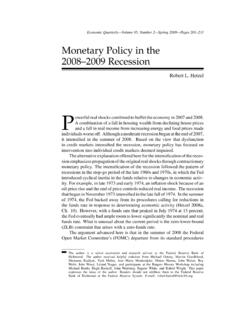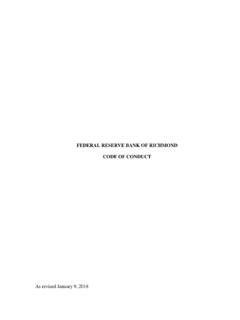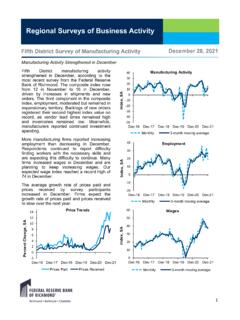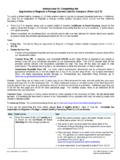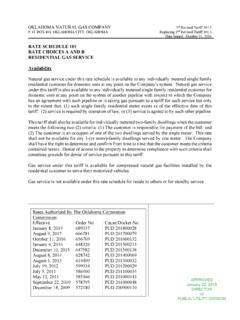Transcription of The Rise and Fall of Circuit City - richmondfed.org
1 ECONOMIC HISTORY. The Rise and Fall of Circuit city BY J E S S I E RO M E RO. The Richmond-based retailer became wildly successful and then disappeared ne of the great success stories of American retail- O ing, Circuit city got its start in 1949 as a tiny storefront in Richmond, Va. From that modest beginning, founder Sam Wurtzel quickly built the company into a national chain, and his son Alan turned it into a household name. By 2000, Circuit city employed more than 60,000 people at 616 locations across the United States. Circuit city is also one of American retailing's great fail- ures. In November 2008, the 59-year-old company filed for bankruptcy. Within months, it closed its stores and liquidat- ed more than $1 billion worth of merchandise, and on March Circuit city got its start as Wards TV, which had a bustling showroom in Richmond, Va., in 1960. 8, 2009, the last Circuit city store turned off its lights for good.
2 Today there are few reminders of the groundbreaking York to Virginia and was selling televisions out of the front retailer; the company 's 700,000-square-foot headquarters half of a tire store on Broad Street, a few blocks west of complex outside Richmond is filling up with new tenants, downtown Richmond. and the empty stores have been taken over by new retailers. Wurtzel thought his last name might be hard for people In part, Circuit city was just one of the many victims of to pronounce, so he named his store Wards, an acronym for the financial crisis and recession, which also brought down his family's names: W for Wurtzel, A for his son Alan, R for other large national retailers such as Linens 'n Things and his wife, Ruth, D for his son David, and S for Sam. Rather The Sharper Image. And businesses fail even during the than try to compete directly with the big department stores, best of economic times, as part of the natural process of he catered to lower-income consumers by offering install- creative destruction that is the engine of capitalism.
3 But at ment payment plans. He also developed a unique sales business schools across the country, Circuit city 's story is technique: free in-home demonstrations. A salesman would taught as an example of what can happen when success drop off a television at a customer's home for the night, free breeds complacency. of charge, and offer to pick it back up the next day. Once the set was in a family's home, they nearly always bought it. From Tire Store to Fortune 500 Wurtzel had correctly foreseen the growing consumer In 1949, New Yorker and serial entrepreneur Sam Wurtzel demand for televisions the number of households with was having his hair cut in Richmond on his way to a family sets grew from under 1 million in 1949 to 20 million by 1953. vacation in North Carolina. The barber mentioned that the and Wards TV grew quickly. In 1952, Wurtzel started first television station in the South had opened in Richmond selling appliances to capitalize on the post-war demand less than a year earlier.
4 Wurtzel, fresh from a failed import- for refrigerators, washing machines, and electric stoves. export business, thought this new entertainment device Richmond was soon home to four Wards TV locations. might be his next opportunity. Wurtzel soon decided to join another retail trend: dis- The first experimental television stations began operat- count stores. The first discount store a huge retail space ing in the early 1940s, and commercial broadcasting began offering a smorgasbord of merchandise below the manufac- after World War II. Few households owned sets at the time turer's list price opened in New England in 1953, and the PHOTOGRAPHY: COURTESY OF AL AN WURTZEL. of Wurtzel's barbershop visit, but the medium was growing format spread quickly. In 1960, the discount chain National rapidly: The number of TV stations in the United States Bellas Hess invited Wurtzel to open a store-within-a-store nearly tripled in 1949, from 27 to 76.
5 Through a friend, called a licensed department at their new Atlanta location. Wurtzel knew someone at Olympic Television, a small Wurtzel quickly followed up with licensed departments in manufacturer in Long Island city ; through relatives, he had Norfolk, Va., and Camden, , and in December 1961 he connections to bankers and businesspeople in Richmond. took Wards TV public to finance a nationwide expansion. Within a month, Wurtzel had moved his family from New Excited by its success, the company embarked on a brash ECON FOCUS | THIRD QUARTER | 2013 31. expansion strategy and nearly went bankrupt in 1975. But led immediately successful, and the chain expanded to 40. by Wurtzel's son Alan, who had become CEO in 1972, the outlets by 2000. Circuit city spun off CarMax in 2002, company closed or sold a number of unprofitable outlets, and today there are more than 120 locations. and by the late 1970s it was ready to start expanding again.
6 Less successful was a new DVD technology, called It did so with a new name and a new retail model inspired DIVX, which launched in 1998. The premise was that by the early discount stores: the Circuit city superstore. consumers could buy a DIVX-encrypted movie and then The superstores featured a large showroom attached to an watch it on a special DVD player as many times as they even larger warehouse, with custom-built display areas to wanted within a 48-hour period. In theory, DIVX was more show off the merchandise. Most significantly, there was no convenient than renting tapes from a video store, but con- central checkout area and customers couldn't pick up sumers didn't like it and other electronics stores refused merchandise themselves. Instead, there were multiple sales to stock DIVX movies. Circuit city abandoned the idea terminals throughout the store and commissioned sales- within a year.
7 People helped the customers make their purchases. The issue was not the success or failure of these projects Those sports-jacketed salespeople were central to per se; CarMax was a great move, and DVIX was costly Circuit city 's business model, which depended on selling but not critically wounding, according to Wurtzel. But in big-ticket, high-margin items and lots of extended service Collins' analysis, the attention paid to these projects meant plans. They were also what customers wanted at the time. that the management team and the board weren't paying Circuit city was at their strongest when consumers didn't attention to the company 's core business or to the grow- really understand what they were buying and were nervous ing threat of Best Buy. about it, says Doug Bosse, a strategy professor at the University of Richmond. When my family bought our first Sacking the city VCR, it was $600. That was a pretty big chunk of a family's Best Buy got its start in 1966 as Sound of Music, an audio discretionary budget.
8 You would go into Circuit city and specialty store with several locations in Minnesota. In 1981, talk to a salesperson and ask for advice, and have them teach the Roseville, Minn., store was destroyed by a tornado, so you on the floor how it would work in your family room. founder Richard Schulze and his employees gathered up the Circuit city superstores, which sold both electronics and merchandise, stacked it on tables in the parking lot, and appliances, spread rapidly, from just eight in 1983 to 53 by advertised a huge Tornado Sale. Customers lined up 1987, in addition to the company 's 37 smaller electronics- around the block, and the success prompted Schulze to only stores. pursue a discount sales strategy. Sound of Music changed its Just like Wards TV, Circuit city was in the right market name to Best Buy in 1983 and opened its first of many super- at the right time. As the baby boomers came of age and the stores in Burnsville, Minn.
9 Country entered the 1980s boom, consumer demand for While the basic model was similar to Circuit city , Best VCRs, CD players, and microwave ovens exploded. Factory Buy stores had a central checkout and allowed customers to shipments of consumer electronics doubled between 1980 pick out their own merchandise on the floor. And unlike and 1986, and the share of households with a VCR grew from Circuit city , Best Buy carried a wide variety of low-margin 1 percent in 1980 to nearly 70 percent by the end of the products to get customers in the door, such as computer decade. As Alan Wurtzel wrote in his memoir Good to Great peripherals, videogames, and CDs. Best Buy's store and to Gone, I often thanked my lucky stars that Sam had staffing models were a better fit for consumers' changing decided to go into the retail electronics business and not the preferences; as consumer electronics became cheaper and retail shoe business.
10 More ubiquitous, customers no longer needed or wanted a Wurtzel stepped down in 1986 and was succeeded by salesperson to help them with many of their purchases. Rick Sharp, an executive vice president, who served as CEO Circuit city , on the other hand, stuck to its commission- until 2000. During Sharp's tenure, sales increased from based sales force and its reliance on high-margin products, $1 billion to $ billion, earnings increased from $22 mil- and watched Best Buy take over its market share. lion to $327 million, and the number of stores increased But Circuit city didn't see Best Buy as a threat. We from 69 to 616. In 1995, Circuit city entered the Fortune thought we were smarter than anybody, says Alan Wurtzel, 500 at number 280, climbing as high as 151 by 2003. Circuit who remained on the board of directors until 2001. But the city was so successful that management expert Jim Collins time you get in trouble is when you think you know the featured the company in his 2001 book Good to Great, a study answers.
